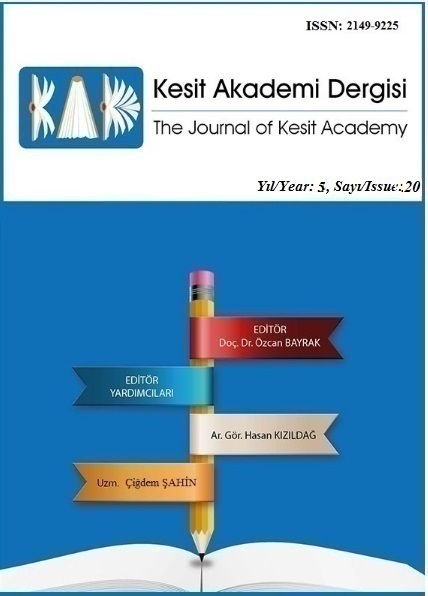Author :
Abstract
Bir metnin edebîlik vasfı kazanması, onun kurgulanmış olmasına bağlı olarak ortaya çıkar. Bu, Aristo’nun “mimesis” (yansıtma) ve “katharsis” (arınma) kavramlarıyla da yakından ilgilidir. Zira, gerçek hayattan alınan olay ya da durum kurmaca dünyada kurgulama unsurlarıyla yeniden ele alınarak estetik bir şekilde sunulur. Böylelikle okurun bu kurmaca dünyada yolculuk yapıp sonunda metnin anlamına ulaşması sağlanır. Dolayısıyla kurgu malzemesini yazar dış âlemden seçmekle birlikte kendi bakış açısıyla eserin iç dünyasında ifâde eder. Hikâyenin kendisi belli bir şekilde yaşayan insanların temsilî bir göstergesi olarak karşımıza çıkarken gösterilen ise, yaşam gerçeği olarak dikkatlere sunulur. Bu çalışmada da edebî eserde olgusal gerçekliğin kurgusal gerçekliğe dönüştürülüşü açısından Orhan Hançerlioğlu’nun “Toprak” adlı hikâyesi ele alınmış ve bir anlatıda hem metnin anlam katmanları hem de derinden yüzeye üretim süreci ortaya konulmaya çalışılmıştır.
Keywords
Abstract
The literary quality of a text depends on its fiction. This is closely related to Aristotle's concepts of “mimesis” (reflection) and “katharsis” (purification). Because, the real life event or situation is presented in an aesthetic way by being re-handled with the elements of fiction in the fictional world. Thus, it is ensured that the reader travels through this fictional world and finally reaches the meaning of the text. Therefore, the author selects the material of the fiction from the outside world, but expresses it in the inner world of the work from his own point of view. While the story itself reflects people who live in a certain way, it is actually the fact of life that is pointed out. In this study, Orhan Hançerlioğlu's "Toprak" story is discussed in terms of the transformation of factual reality into fictional reality in the literary work and the production process of the text is tried to be put forward.
Keywords
- Aktaş, Şerif (2000). Roman Sanatı ve Roman İncelemesine Giriş, Ankara: Akçağ Yayınları.
- Aktaş, Şerif (2000). Roman Sanatı ve Roman İncelemesine Giriş, Ankara: Akçağ Yayınları. Antakyalıoğlu, Zekiye (2016). Roman Kuramına Giriş, İstanbul: Ayrıntı Yayınları.
- Aytaç, Gürsel (2009). Genel Edebiyat Bilimi, İstanbul: Say Yayınları.
- Bolat, Salih (2009). Öykü Yazma Teknikleri, İstanbul: Varlık Yayınları.
- Çetişli, İsmail (2009). Kurgusallık/İtibârîlik Bağlamında Edebiyat, A.Ü. Türkiyat Araştırmaları Enstitüsü Dergisi S. 39, s. 365-376.
- Erkman Akerson, Fatma(2005). Göstergebilime Giriş, İstanbul: Multılıngual.
- Erkman Akerson, Fatma (2012). Edebiyat ve Kuramlar, İstanbul: İthaki Yayınları. Kaplan, Mehmet (2000). Hikâye Tahlilleri, Dergâh Yayınları, İstanbul.
- Kıbrıs, İbrahim (2004). Cumhuriyet Dönemi Türk Edebiyatı, Ankara: Anı Yayıncılık.
- Kıran, Zeynel ve Kıran (Eziler) Ayşe (2011). Yazınsal Okuma Süreçleri, Ankara: Seçkin Yayıncı- lık.
- Kolcu, Ali İhsan (2015). Edebiyat Kuramları, Salkımsöğüt Yayınları, Erzurum. Tural, Sadık (1993). Edebiyat Bilimine Katkılar, Ecdâd Yayınları, Ankara.
- Wellek Rene ve Warren Austin (1993). Edebiyat Teorisi (Çev: Ömer Faruk Huyugüzel), İzmir: Akademi Kitabevi.
- Yücel, Tahsin (2015). Yapısalcılık, İstanbul: Can Yayınları.





